Resellos on sábanas - Central Mexico (Guanajuato, San Luis Potosí)
Guanajuato – Jefatura Superior de Hacienda
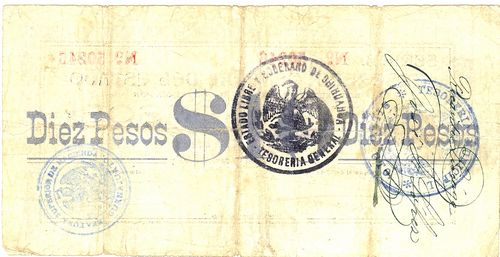
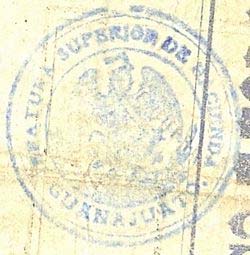 A round (31mm) blue stamp with ‘JEFATURA SUPERIOR DE HACIENDA – GUANAJUATO’ with eagle in centre.
A round (31mm) blue stamp with ‘JEFATURA SUPERIOR DE HACIENDA – GUANAJUATO’ with eagle in centre.
Guanajuato, the state capital, is located 370 kilometres northwest of Mexico City.
The rebels captured Guanajuato on 28 July 1914. On 21 August the Governor, General Pablo A. de la Garza, wrote to the Jefatura de Hacienda, saying that as the sábanas lent themselves to counterfeiting, his government had thought it prudent not to make them of forced circulation within the state but to suggest to the public that they take them to the Jefaturas de Hacienda, as they would be able to authenticate the notes and were authorised to exchange them for others of forced circulationCrispín Espinosa, Efemérides Guanajuatenses, Guanajuato, 1920. It was reported that on 27 August an office was set up in a van (furgon) in the railway station to change cartones and billetes carrancista for dinero and billetes de banco.. On 1 September 1914 Enrique Campacos, the Administrador General de Rentas, listed the notes that his office would accept, including the sábanas, dos caritas and Ejército ConstitucionalistaEl Observador, 7 September 1914. Later the sábanas were made of forced circulation, in accordance with other decreesIn December 1914 the Governor and Comandante Militar stated that Constitucionalist and Villista notes were of forced circulation (Periódico Oficial, 3 December 1914).
Perhaps the offices restamped them because they did not have enough notes to exchange them.
During the first half of 1915 Guanajuato and Aguascalientes were the major battleground between Villa and Obregón and the economic situation in the two states deteriorated. On 28 February the Jefe de Armas and Presidente Municipal of Guanajuato was complaining that many businesses were refusing to accept the Chihuahua notes, even thought they composed the Chamber of Commerce that had agreed that the notes should be of forced circulation, once they were restamped, and had set up the restamping office.
Guanajuato – Ejército Constitucionalista
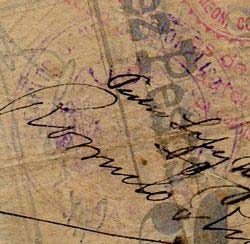 a circular ‘EJERCITO CONSTITUCIONALISTA - GUANAJUATO’ with eagle in centre.
a circular ‘EJERCITO CONSTITUCIONALISTA - GUANAJUATO’ with eagle in centre.
León – Presidencia Municipal
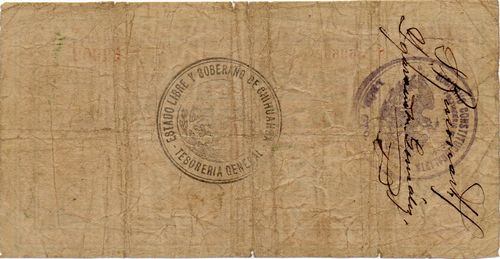
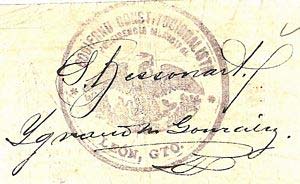 A round (40mm) black seal with ‘GOBIERNO CONSTITUCIONALISTA - PRESIDENCIA MUNICIPAL’ above and ‘LEÓN, GTO.’ below encircling an eagle, endorsed with the signatures of J(?). Bessonart and Ignacio M. González.
A round (40mm) black seal with ‘GOBIERNO CONSTITUCIONALISTA - PRESIDENCIA MUNICIPAL’ above and ‘LEÓN, GTO.’ below encircling an eagle, endorsed with the signatures of J(?). Bessonart and Ignacio M. González.
San Francisco del Rincón
'TESORERIA [ ] DE SAN FRANCISCO DEL RINCON - ESTADO DE GTO'
Dolores Hidalgo
'Revalidado, Dolores Hildalgo, Gto.'
Dolores Hidalgo, the birthplace of Mexican independence, is in the north-central part of Guanajuato.
This was possibly a revalidation carried out in the Jefatura de Hacienda in accordance with the Convention's decree of 23 January 1915.
Silao – Tesorería Municipal

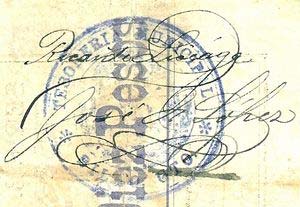 A large (41mm) round dark blue stamp with ‘TESORERIA MUNICIPAL - SILAO, GTO.’ and eagle in centre and signatures of Ricardo Liceaga and José H. López.
A large (41mm) round dark blue stamp with ‘TESORERIA MUNICIPAL - SILAO, GTO.’ and eagle in centre and signatures of Ricardo Liceaga and José H. López.
Silao is a city in the west-central part of Guanajuato.
Miguel Hidalgo – Jefatura Política
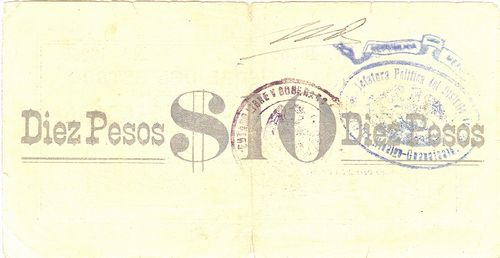
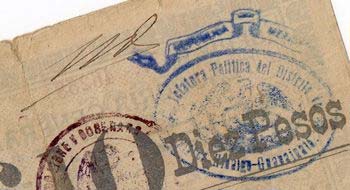 A blue oval (48mm) stamp with ‘Jefatura Politica del Distrito de - Miguel Hidalgo, Guanajuato’ with eagle in centre and ‘REPUBLICA MEXICANA’ in ribbon above.
A blue oval (48mm) stamp with ‘Jefatura Politica del Distrito de - Miguel Hidalgo, Guanajuato’ with eagle in centre and ‘REPUBLICA MEXICANA’ in ribbon above.
Jefaturas políticas were the intermediate administrative tier between the state and the municipalities. The district of Miguel Hidalgo [ ]
Pénjamo – Presidencia Municipal
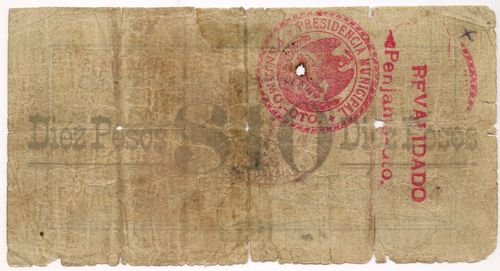
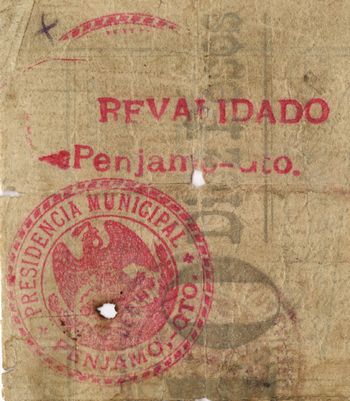 Pénjamo is a city in the southwest of the state.
Pénjamo is a city in the southwest of the state.
REVALIDADO / Penjamo – Gto. and a red circular seal with Eagle and ‘PRESIDENCIA MUNICIPAL / PENJAMO. – GTO.’
San Luis Potosí – Prefectura Regional
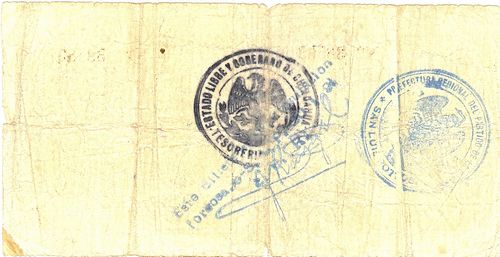
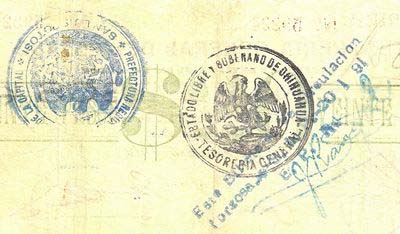 A blue circular (43.5mm) rubber stamp with the legend ‘PREFECTURA REGIONAL DEL PARTIDO DE LA CAPITAL - SAN LUIS POTOSI’ and an eagle in the centre, together with a three-line inscription ‘Este Billete es de circulacion forzosa. S.L.P.....1915 E.P.R’ and the stamped signature of J. Rangel.
A blue circular (43.5mm) rubber stamp with the legend ‘PREFECTURA REGIONAL DEL PARTIDO DE LA CAPITAL - SAN LUIS POTOSI’ and an eagle in the centre, together with a three-line inscription ‘Este Billete es de circulacion forzosa. S.L.P.....1915 E.P.R’ and the stamped signature of J. Rangel.
The Constitutionalists captured San Luis Potosí in July 1914. On 19 July General Pablo González decreed that the Huertista notes from Saltillo and Monterrey were worthless and that the paper money issued by the Constitutional government was of forced circulationPeriódico Oficial, 1 August 1914. On 24 August Coronel Ignacio Ramos of the Prefectura Regional de la Capital warned the public that the two Chihuahua issues were of forced circulation. The notes would be exchanged for other Constitutionalist currency at a later date if the authorities decided to withdraw them, but the public would be given sufficient noticePeriódico Oficial, 27 August 1914. However, Ramos made no mention of revalidation. The notes were also listed as forced in October 1914Periódico Oficial, 23 October 1914.
In the beginning of 1915 Eulalio Gutiérrez broke with the Conventionists, took part of the treasury and tried to install a national government in San Luis Potosí, with the support of Aguirre Benavides and the neighbouring governor of Hidalgo. On 1 February General Tomas Urbina and his Villistas took the city peacefully and General Emiliano Saravia was named governor.
By March the Prefecto Regional, A. B. Cortes, was liaising with the Jefatura de Hacienda over the matter of currencyPeriódico Oficial, 10 March 1915. On 3 March the Jefatura set up an office in the old Banco de San Luis Potosí for exchanging sábanas and checking dos caritas though only sábanas of five pesos and above were to be exchangedThe offices were open from 10am until 1pm. Periódico Oficial, 6 March 1915. On 11 March an office (for exchange and revision) was established in the basement of the Jefatura de Armas, under the direct order of the Tesorería General del Estado de ChihuahuaPeriódico Oficial, 13 March 1915.
The resello appears to imply that J. Rangel was E(l) P(refecto) R(egional) but a Juan Rangel had been a porter (conserje) in the Sección de Correspondencia y Archivo of the Tesorería General of Chihuahua in September 1914AAC, Ejecutivo Sec 2ª Hacienda C-1 Año 1915 exp. 167 , reply of Administrador Local de Correos to governor, 23 March 1915 and might have been the expert sent from Chihuahua.
The Carrancistas occupied San Luis Potosí in July 1915.
